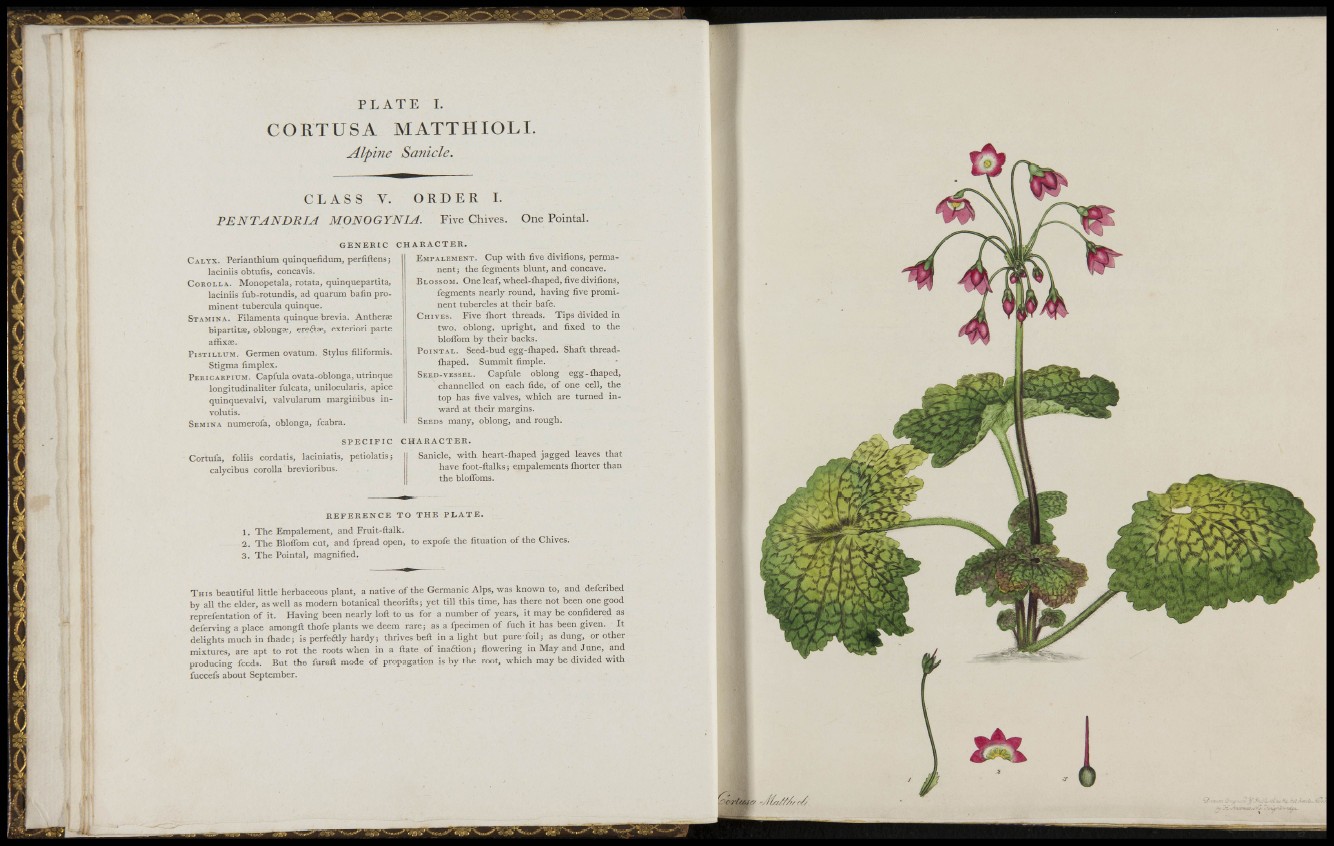
I
P L A T E I.
CORTUSA MATTHIOLI.
Alpine Sanicle.
C L A S S V. ORDER L
PENTANDRIJ MONOGYNIA. Five Chives. One Pointal.
G E N E R I C CHARACTER.
EMPALEMENT. Cup with CALYX. Perianthlum quinquefidum, perfiftens; five divifions, permalaciniis
obtufis, concavis.
COROLLA. Monopetala, rotata, quinquepartita,
laciniis lub-rotundis, ad quarum bafin prominent
tubercula quinqué.
STAMINA. Filamenta quinqué brevia. Antherae
bipartitse, oblonga;, ereñae, exteriori parte
affixae.
PiSTiLLUM. Germen ovatum. Stylus filiformis.
Stigma fimplex.
P E R I C A R P I U M . Capfula ovata-oblonga, utrinque
longitudinaliter fulcata, unilocularis, apice
quinquevalvi, valvularum marginibus involutis.
SEMINA numerofa, oblonga, fcabra.
nent; the fegments blunt, and concave.
BLOSSOM. One leaf, wheel-lliaped, five divifions,
fegments nearly round, having five prominent
tubercles at their bafe.
CHIVES. Five fliort threads. Tips divided in
two, oblong, upright, and fixed to the
blolTom by their backs.
P O I N T A L . Seed-bud egg-lliaped. Shaft threadfhaped.
Summit fimple.
SEED-VESSEL. Capfule oblong egg-lhaped,
channelled on each fide, of one cell, the
top has five valves, which are turned inward
at their margins.
SEEDS many, oblong, and rough.
S P E C I F I C CHARACTER.
Cortufa, foliis cordatis, laciniatis, petiolatis;
calycibus corolla brevioribus.
Sanicle, with heart-fliaped jagged leaves that
have foot-ftalks ; empalements fliorter than
the bloffoms.
R E F E R E N C E TO THE PLATE.
1. The Empalement, and Fruit-ftalk.
2. The BloiTom cut, and fpread open, to expofe the fituation of the Chives.
3. The Pointal, magnified.
T H I S beautiful little herbaceous plant, a native of the Germanic Alps, was known to, and defcribed
by all the elder, as well as modern botanical theorifts; yet till this time, has there not been one good
reprefentation of it. Having been nearly loft to us for a number of years, it may be confidered as
deferving a place amongft thofe plants we deem rare; as a fpecimen of fuch it has been given. It
delights much in ihade; is perfeaiy hardy; thrives beft in a light but pure-foil; as dung, or other
mixtures, are apt to rot the roots when in a ftate of inadion; flowering in May and June, and
producing feeds. But the fureft mode of propagation is by the root, which may be divided with
fuccefs about September.
sicrt/Mc o